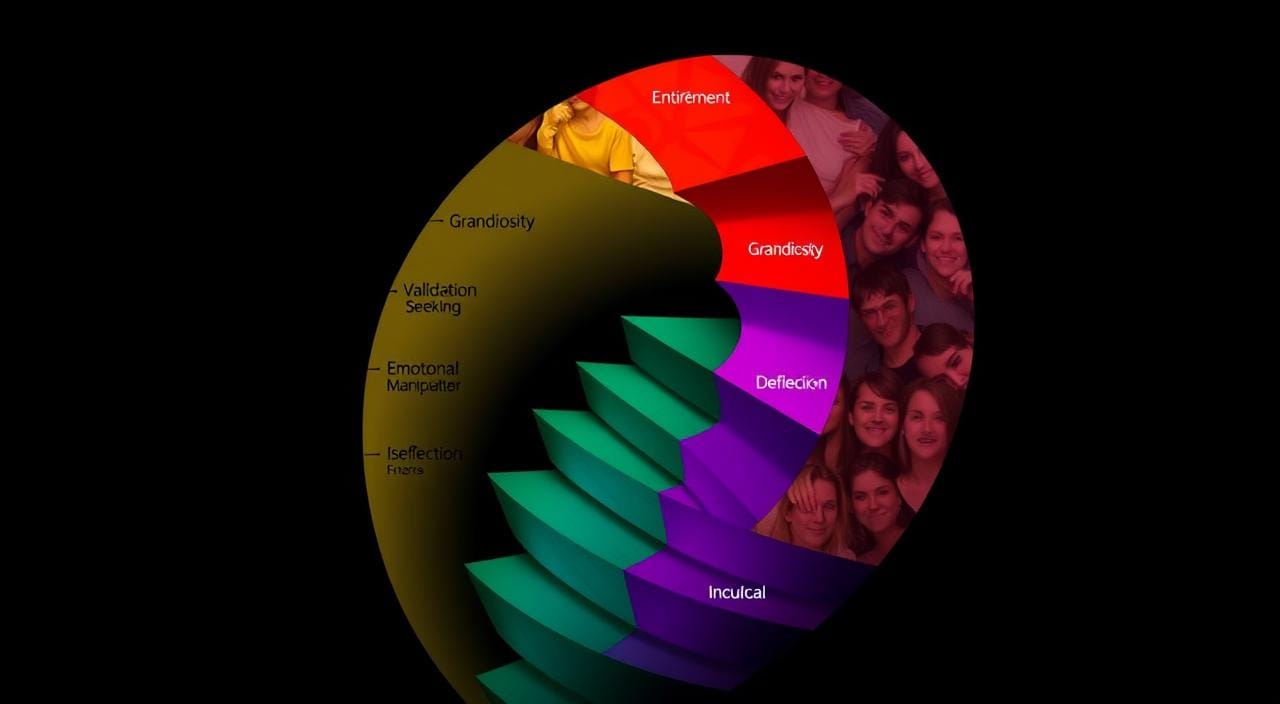Have you ever felt the closest to someone who constantly puts you down and controls you? If so, then you could be trauma-bonded to a narcissist.
In this blog post, I am going to discuss what a trauma bond is and how to break a trauma bond with a narcissist.
People with NPD have a tendency to brag about themselves, seem to have very little regard for other people’s feelings and seek excessive admiration1. They will manipulate — through gaslighting — a person to question what is real. The damage you sustained from being in a relationship with a narcissist lingers well after you have moved on from them.
Key Takeaways
- Trauma bonding refers to a psychological attachment between an abuser and their victim.
- Narcissists reach control over their victims through emotional abuse, gaslighting, and manipulation.
- A victim feels confused, helpless, and dependent on the abuser, hence hardly able to break free.
- Narcissistic abuse can have long-lasting effects on mental health and well-being.
- Professional help and support groups could be important in the healing process.
Understanding Trauma Bonding with a Narcissist
What is a Trauma Bond?
A trauma bond is what occurs between the abuser and the victim. It creates a cycle of abuse and manipulation that binds a victim emotionally to an abuser. Narcissists hold people in place through love bombing, devaluation, and gaslighting. This forms an emotional connection and loyalty in the victims, even when ties are unhealthy and abusive.
Trauma bonding is able to leave victims with no empathy, only staying focused on the narcissist’s needs. The victim may get physical abuse, which can lead to health complications such as chronic pain and complications like headaches. It may also be the cause of anxiety disorders and PTSD, which means that flashbacks and nightmares can happen to those people who have gone through experiences.
Victims can suffer low self-esteem and emotional problems after trauma bonding4. Emotionally, they can feel drained, anxious, and depressed4. They begin distrusting people and find it hard to maintain healthy relationships, hence living in isolation.
Trauma bonding even affects work life, causing reduced productivity due to increased stress levels. The bond can cause burnout, increased work pressure, and a feeling that one is losing the ability to hold onto the job.
“Trauma bonding can occur within romantic or non-romantic relationships. It can take time to realize that you are in a toxic relationship due to the abuser switching between abuse and positive actions.’’
People with poor mental health, especially those with low self-esteem, are more prone to trauma bonding. Feeling one owes the abuser and protecting them are signs. Having no support or being a subject of trauma in the past increases the risk as well.
Trauma bonding was first coined by Dr. Patrick Carnes in 19972. Any relationship can form a trauma bond, but it most often occurs in romantic relationships. Narcissistic conditions or traits can be mild or severe, with very harmful behaviors.
Trauma bonding can lead to hyperfocus on the narcissist at the expense of losing empathy. It can cause psychological issues and physical ailments in the body. Breaking free can lead to withdrawal symptoms, just like a person coming off drugs, but not all victims experience a trauma bond.
Symptoms of Narcissistic Abuse (10 Signs)
It is only by recognizing the symptoms of narcissistic abuse that one can free themselves from a narcissist. Common conditions described in such victims include PTSD, Complex PTSD, or Narcissistic Victim Syndrome by Cannonville, 2015 and Staggs, 2016. Such victims may be noted to dissociate from the experiences, which destroys memory and a sense of self, as reported by Dr. Van der Kolk, 2015.
This will most assuredly cause health problems, weight changes, and sleep issues in the long term, raising the level of cortisol and weakening a person’s immune system. This was found in 2013 by Bergland and Walker5. It also places people who have narcissistic abusers at an increased risk of trying suicide several times. This was shown in 2014 by Dr. McKeon.
The victim’s abuse claims may be questioned by those around the narcissist, pressuring the victim to withdraw. Victims measure themselves against others or even self-blame for the abuse or fear success based on the narcissist’s tactics5. Psychological abuse can lead the victims to abandon their needs and desires to satiate the narcissist.
- Confusing Intensity for Intimacy: As in a narcissistic relationship, ups and downs may get confused for deep connection.
- Justification of Abuse: The victim makes excuses for the abuse, blaming it on outside circumstances or themselves.
- Difficulty Leaving: People cannot leave despite knowledge of harm due to emotional attachments.
- Alternating Cycles of Abuse and Kindness: Alternating between passionate love and cruel treatment produces an unnatural need for the abuser.
- Isolation from Support Systems: Isolation from friends and family happens gradually and makes people rely more heavily on the abuser.
- Intense Fear of Abandonment: A fear of being alone causes the victim to endure abuse and ill-treatment.
- Feeling Stuck or Helpless: Feeling trapped diminishes the victim’s self-esteem and makes them less independent.
- Protecting the Abuser: The victim often takes the abuser’s side and may deny or minimize the abuse to others.
- Feeling Withdrawal Symptoms: A feeling of withdrawal, like addiction, sets in when the victim is away from the abuser6.
- Neglect of Personal Needs: Standing by the wishes of the abuser over their personal well-being leads to neglect of oneself.
Trauma Bond with a Narcissist
The Cycle of Abuse

The trauma bond with a narcissist begins with idealization. The narcissist showers the victim with much attention and praise, making them feel special. This only lasts for a little while. Then, the narcissist devalues the victim by criticizing and ignoring them, making them feel dependent.
This idealization/devaluation cycle keeps on repeating. The narcissist keeps switching between these two, deepening the trauma bond.
Trauma bonding theory was first discussed by Dutton and Painter in 19817. Nevertheless, the bond may be very strong even after the relationship ends. The victim continues holding on to a few nice moments during abuse. The tricks of narcissists make it difficult for the victim to exit the abuse cycle.
Trauma bonds can be established within a period of days or be more gradual, depending on the context. Some factors that enable trauma bonding to occur include danger, being mistreated with occasional gentleness, feeling trapped and manipulative strategies by the abuser.
People who are in an abusive relationship often look for acceptance from the abusers. They will hold onto a very small baseline on which the relationship will work out better, and such hope makes the bond more solid.
To set them free, they require support, a focus on safety, and simply just stop talking to the abuser.
How To Break Trauma Bond With a Narcissist: A Guide

Breaking a trauma bond with a narcissist is not easy, but it is the key to taking back your life. The following guide provides strategies to assist in freeing oneself from abuse and finding self-worth once more.
Going No Contact comes first, and literally so: it means that all ties between you and the narcissist are severed, social media and mutual friends included. Hard, yes, but needed in order to stop the cycle that keeps that bond alive9.
Positive behavior enforcement is also critical. Rewarding yourself for small wins, such as setting boundaries or caring for yourself, reinforces new positive habits. It may also enhance your confidence.
Therapists, groups, and resources are very important for seeking support. They provide a guide and validation to the healing process. Sharing stories with others who have gone through similar things can make you feel less alone and more connected.
Validating Your Experience is important. Narcissists engrain self-doubt into the human brain. Therefore, it is real, and damage having been done to you does matter.
“Anger, not empathy, nor forgiveness-is what allows a trauma bond with a narcissist to be broken.’’
Fahim Chughtai
Getting over a trauma bond with a narcissist is hard, but it is well worth it. These strategies can stop the abuse cycle, regain your self-esteem, and empower you again. Always remember that you are not alone in this. The trauma bond can be broken, and a new beginning can be set in motion, provided the right help and will to do so are present.
Trauma Bonding and Manipulation Tactics
They are skillfully great at manipulating their victims. In their arsenal of tools is gaslighting, which makes the victim doubt his or her perception of reality. This puts the victim off balance by making him continuously turn to the narcissist’s “reality” for more and more support.
They also punish and show power by using silent treatment. This lack of attention and love causes a lot of pain. This is so because victims need an okay from the narcissist. The constant criticizing devaluation may lower victims’ self-esteem and make them easy to manipulate.
Narcissists also use rewards as a means. They dispense affection, praise, or small favors, keeping the victim within the trap. It is through this intermittent reinforcement that a strong bond, akin to addiction, is created in narcissistic abuse.
The knowledge of these manipulation strategies empowers victims to break free from the trauma bond. It is by seeing how the narcissist acts that victims can take their power back and muster the courage to leave the toxic relationship.
“Trauma bonding is the betrayal bond, the attachment to someone who is dangerous to you.” — Dr. Patrick Carnes
Last Words on Breaking Trauma Bond With a Narcissist
Breaking a trauma bond with a narcissist is the hard but essential journey to healing and taking back one’s identity. Now, understanding the trauma bonding and its power imbalance can help in understanding how narcissists manipulate people. This knowledge is crucial in putting an end to the abuse and seeking a better life.
Trauma bonding is not easy to recover from — it’s a deep psychological attachment formed in desperate times. Many victims move their abusers into first place and put up with destructive behavior. However, you can regain your life by breaking the relationship, getting professional help, and learning to love yourself by setting healthy boundaries.
Healing will not be easy, but with the right support and tools, you can overcome narcissistic trauma bonds. This can further enhance your self-esteem and well-being and keep you from falling into the same patterns over and over again in future relationships. First, begin to put your needs first to break free and finally live life to the fullest.
FAQs On Breaking Trauma Bond With a Narcissist
What is a trauma bond?
A trauma bond refers to the strong emotional attachment between an abuser and a victim. This is often the case in situations of narcissistic abuse. An emotional bonding of the deepest kind that the victim may feel with his or her abuser culminates in a trauma bond.
How do narcissists create a trauma bond?
Narcissists use emotional abuse and manipulation to sustain the control of their victims. They leave one feeling confused, helpless, and dependent on them, making it quite hard to exit such a trauma bond.
What, then, are the indications of a trauma bond with a narcissist?
Some are charming and charismatic, while others involve gaslighting, constant criticism, idealization, devaluation, and a discard cycle. Victims may feel confused, helpless, and emotionally attached to their abuser.
How does the cycle of abuse lead to a trauma bond?
The idealization stage is the cycle of abuse with the narcissist. First, he gives his victim much attention and praise, making them feel special. Then the devaluation stage occurs, during which the narcissist will put down the victim and withdraw his affection. The victim is emotionally and psychologically dependent due to this cycle.
How can one break a trauma bond with a narcissist?
Breaking the trauma bond does require a well-thought-out plan. First of all, go no contact. Just completely cut ties with the narcissist. Positively reward new actions, and that’s good for building new habits. Seek therapists, support groups, and education on narcissism and trauma bonding. Feel your feelings; it will aid in the healing process.
What are some of the manipulation tactics that narcissists use to maintain this trauma bond?
Narcissists will hang on to control using such tactics as gaslighting, silent treatment, devaluation, and reward. Gaslighting will make a victim doubt their reality. Silent treatment will punish and control the victim. Devaluation criticizes and belittles them, while reward manipulates their behavior.
Source Links
How do you break a trauma bond From a narcissist? — Judge Anthony – https://www.judgeanthony.com/blog/how-do-you-break-a-trauma-bond-from-a-narcissist
Breadcrumb – https://www.sabinorecovery.com/how-to-break-a-trauma-bond-with-a-narcissist/
Trauma Bonding: Definition, Examples and the role of Narcissism – https://www.attachmentproject.com/psychology/trauma-bonding/
Trauma Bonding: What Is It and Why Do We Do It? – https://amfmtreatment.com/trauma-bonding-what-is-it-and-why-do-we-do-it/
Breadcrumb – https://www.sabinorecovery.com/what-does-a-trauma-bond-with-a-narcissist-look-like/
11 Signs Youre the Victim of Narcissistic Abuse – https://psychcentral.com/blog/recovering-narcissist/2017/08/11-signs-youre-the-victim-of-narcissistic-abuse
10 Signs of Trauma Bonding – https://grace-being.com/love-relationships/10-signs-of-trauma-bonding/
Why Does Loving You Hurt? Understanding Trauma Bonds with a Narcissist – https://www.family-institute.org/behavioral-health-resources/why-does-loving-you-hurt-understanding-trauma-bonds-narcissist
Trauma Bond With Narcissist: Signs And Solutions – https://mhcsandiego.com/blog/trauma-bond-with-a-narcissist/
10 Shocking Ways To Break A Trauma Bond With A Narcissist – https://thoughtcatalog.com/shahida-arabi/2023/01/10-shocking-ways-to-break-a-trauma-bond-with-a-narcissist/
How to Break a Trauma Bond with a Narcissist – Dear Media – https://dearmedia.com/how-to-break-a-trauma-bond-with-a-narcissist/
How Narcissists And Psychopaths Create Powerful Trauma Bonds: 6 Common Manipulative Tactics – https://thoughtcatalog.com/shahida-arabi/2023/01/how-narcissists-and-psychopaths-create-powerful-trauma-bonds-6-common-manipulative-tactics/
Narcissists Use Trauma Bonding and Intermittent Reinforcement To Get You Addicted To Them: Why Abuse Survivors Stay – https://psychcentral.com/blog/recovering-narcissist/2019/03/narcissists-use-trauma-bonding-and-intermittent-reinforcement-to-get-you-addicted-to-them-why-abuse-survivors-stay
Break Free: Recognizing and Ending Trauma Bonds — Nicholas Purcell Psychotherapist – https://www.nicholaspurcell.com.au/relationships-blog/are-you-trauma-bonding-with-a-narcissist







